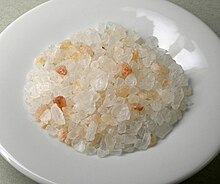Himalayan salt
From Wikipedia, the free encyclopedia
| This article relies on references to primary sources or sources affiliated with the subject. (March 2008) |
Himalayan salt is a marketing term for Halite (commonly known as rock salt) from Pakistan, which began being sold by various companies in Europe,North America, and Australia in the early 21st century. It is mined in the Khewra Salt Mines, the second largest salt mine in the world, located inKhewra, Jhelum District, Punjab, Pakistan, about 300 km from the Himalayas, about 160 kilometres from Islamabad, and 260 kilometres from Lahore, and in the foothills of the Salt Range. The salt sometimes comes out in a reddish or pink color, with some crystals having an off-white to transparent color. It is commonly used for cooking similar to regular table salt, brine, and bath products.
Contents[hide] |
[edit]Mineral composition
In 2003 the Bavarian consumer protection agency Bayerisches Landesamt für Gesundheit und Lebensmittelsicherheit analyzed 15 specimens of Himalaya salt sold in Germany and could detect a total of 10 different minerals: sodium and chloride (98%) and other minerals. This agency states that these salts come from Pakistanand can, like all salts, cause hypertension (high blood pressure).[1] German public television broadcaster ZDF presented the analyzed chemical composition of Himalayan salt, stating that the specimen contained 95–96% sodium chloride that was contaminated with 2–3% polyhalite (gypsum) and small amounts of 10 other different minerals.[2][dead link]
[edit]Uses
[edit]Salt lamps
Large crystal rocks are also used as salt lamps. A salt lamp is a lamp carved from a larger salt crystal, often colored, with an incandescent bulb or a candle inside. The lamps give an attractive glow and are suitable for use as nightlights or for ambient mood lighting. Mined in Europe and Asia, salt crystals emit a soft glowing light and are hand-carved. Many believe that heated salt crystals' emission of negative ions into the air gives the feeling of being on the beach, on a mountain top, or near a waterfall. [3] . However, there is no evidence that salt lamps actually give out a measurable amount of "negative ions" nor is there any scientific evidence of any health benefits from the lamps. [4]
[edit]Salt blocks
Blocks of Himalayan salt may be used to serve, cook, and cure food. These techniques have been featured on Iron Chef[5] and have also been adopted by chefs.[6]
[edit]Food
The salt is used in the Andalucian San Nicasio potato chips.[7]
[edit]Similar salts
Rock salts mined in several parts of the world, including Chile, Hawaii, Utah, Bolivia, the Murray-Darling basin of Australia, Peru and Poland. The pink color results from iron oxide.




No comments:
Post a Comment